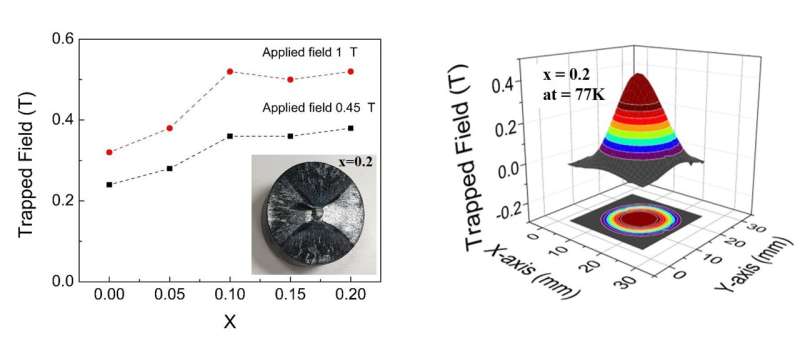On the road to practical, low-cost superconductors with unexplored materials

Superconductors' unique property of zero resistance can revolutionize power transmission and transport. However, most conventional superconductors require cooling to extremely low temperatures that can only be achieved with liquid helium, an expensive coolant. Materials scientists are now investigating high-temperature superconductors (HTSs) that can be cooled to a superconducting state by using the significantly cheaper liquid nitrogen, which has a remarkably higher temperature than liquid helium.
Currently, a prospective HTS material for such an exploration is (RE)Ba2Cu3Oy, RE-123, where RE stands for rare earth elements such as yttrium (Y), gadolinium (Gd), erbium (Er), neodymium (Nd), or europium (Eu). These materials in the single-crystalline form are able to overcome physical constraints that weaken superconductivity, thereby opening doors to a variety of engineering applications.
In a recent study published in the Journal of Alloys and Compounds, a team of scientists from Shibaura Institute of Technology, Japan, led by Prof. Muralidhar Miryala, a pioneer in the area of HTS, developed single-crystalline bulk superconductors that can trap magnetic fields within them in a manner similar to how ferromagnets (iron, nickel, cobalt) retain the magnetic field. "The trapped field is one of the most relevant parameters in many practical applications of bulk RE-123 and is related to the bulk diameter," explains Prof. Miryala.
Among the several techniques available for fabricating bulk RE-123, the team went for an infiltrated growth (IG) technique, in which solid (RE)BaCuO5 (RE-211) reacts with a Ba-Cu-O liquid phase to form the superconducting RE-123. Prof. Miryala lays down the motivation behind their approach: "IG technique produces RE-123 bulks without homogeneities, can be performed in air, and scaled up to industrial levels. Moreover, it provides a fertile ground for exploring ternary RE elements systems, which have not been studied until now."
Recently, the team investigated the ternary (Gd0.33Y0.33-xEr0.33+x)-123 bulk system, optimizing its composition by tuning the ratio of Y and Er in the 211 precursor (specifically, x = 0, 0.05, 0.1, 0.15, and 0.2). The team characterized the superconducting phases in the samples using X-ray diffraction and measured the trapped field and superconducting transition temperature (Tc). Finally, they carried out microstructural and chemical analysis using field-emission scanning electron microscope (FESEM) and energy-dispersive X-ray spectroscopy (EDX).
The XRD proved the single-crystalline nature of the RE-123 bulks, with Tc values in the range (91.5-92) K, which were significantly above the boiling point of liquid nitrogen (77K), and the highest trapped field of 0.53 tesla was observed in (Gd0.33Y0.13Er0.53)-123 (x=0.2). FESEM and EDX identified finely dispersed (Gd, Y, Er) -211 particles in all samples, with an Er-rich precipitates distribution for x=0.2, the sample which also showed the best superconducting performance.
"The findings in our study provide a notion of how to implement a low-cost production of high-performance (Gd, Y, Er)BCO bulks for real-life applications such as magnetic levitation, superconducting bearing, flywheel energy storage, magnetic resonance imaging, rotary motors, drug delivery and water purification," says Prof. Miryala.
More information: S. Pinmangkorn et al, (Gd,Y,Er)Ba2Cu3Oy bulk superconducting system processed via infiltration growth, Journal of Alloys and Compounds (2021). DOI: 10.1016/j.jallcom.2021.160535
Provided by Shibaura Institute of Technology





















